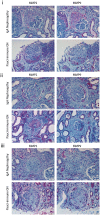MMP2 and MMP9 associate with crescentic glomerulonephritis
- PMID: 28584626
- PMCID: PMC5455255
- DOI: 10.1093/ckj/sfw111
MMP2 and MMP9 associate with crescentic glomerulonephritis
Abstract
Background: Systemic lupus erythematosus (SLE) is a systemic autoimmune disease characterized by multiple organ involvement. Lupus nephritis (LN) is a common manifestation with a wide variety of histological appearances. Matrix metalloproteinases (MMP) 2 and 9 are gelatinases capable of degrading glomerular basement membrane type IV collagen, which have been associated with LN. We examine the expression of MMP2 and MMP9 in different classes of LN. Methods: MMP2 and MMP9 expression was detected by immunohistochemistry in sections from renal biopsy specimens with class III, class IV and class V LN (total n = 31), crescentic immunoglobulin A nephropathy (n = 6), pauci-immune glomerulonephritis (n = 7), minimal change disease (n = 2), mesangiocapillary glomerulonephritis (n = 7), diabetic nephropathy (n = 12) and histologically normal controls (n = 8). Results: MMP2 and MMP9 were not expressed in all classes of LN, but were observed in LN with cellular and fibrocellular crescents. MMP2/MMP9 was expressed in cellular and fibrocellular crescents regardless of glomerulonephritis but not observed in inactive fibrous crescents or with mesangial proliferation. This suggests that MMP2 and MMP9 are involved in the development of extracapillary proliferative lesions. Conclusions: MMP2/MMP9 is expressed with active extracapillary proliferation. Further study is necessary to define whether the expression of MMP2/MMP9 reflects a role in glomerular repair after injury, a role in organ-level immune responses or a role as a marker of epithelialization.
Keywords: crescentic glomerulonephritis; glomerulonephritis; immunoglobulin A nephropathy; metalloproteinase; systemic lupus erythematosus.
Figures


Similar articles
-
Glomerular capillary and endothelial cell injury is associated with the formation of necrotizing and crescentic lesions in crescentic glomerulonephritis.J Nippon Med Sch. 2015;82(1):27-35. doi: 10.1272/jnms.82.27. J Nippon Med Sch. 2015. PMID: 25797872
-
Glomerular expression of C-C chemokines in different types of human crescentic glomerulonephritis.Nephrol Dial Transplant. 2003 Aug;18(8):1526-34. doi: 10.1093/ndt/gfg172. Nephrol Dial Transplant. 2003. PMID: 12897090
-
Antineutrophil Cytoplasmic Autoantibody-Negative Pauci-Immune Crescentic Glomerulonephritis in a Patient with Systemic Lupus Erythematosus.Case Rep Nephrol Dial. 2022 Oct 20;12(3):201-206. doi: 10.1159/000527248. eCollection 2022 Sep-Dec. Case Rep Nephrol Dial. 2022. PMID: 36465575 Free PMC article.
-
Crescentic Glomerulonephritis: an update on Pauci-immune and Anti-GBM diseases.Adv Anat Pathol. 2012 Mar;19(2):111-24. doi: 10.1097/PAP.0b013e318248b7a1. Adv Anat Pathol. 2012. PMID: 22313839 Review.
-
Diabetic nephropathy with anti-GBM nephritis.Am J Kidney Dis. 1998 Jan;31(1):127-30. doi: 10.1053/ajkd.1998.v31.pm9428463. Am J Kidney Dis. 1998. PMID: 9428463 Review.
Cited by
-
Integrated Bioinformatics Analysis Exhibits Pivotal Exercise-Induced Genes and Corresponding Pathways in Malignant Melanoma.Front Genet. 2021 Feb 18;11:637320. doi: 10.3389/fgene.2020.637320. eCollection 2020. Front Genet. 2021. PMID: 33679872 Free PMC article.
-
Vangl2, a planar cell polarity molecule, is implicated in irreversible and reversible kidney glomerular injury.J Pathol. 2018 Dec;246(4):485-496. doi: 10.1002/path.5158. J Pathol. 2018. PMID: 30125361 Free PMC article.
-
Identification of MMP9 as a novel key gene in mantle cell lymphoma based on bioinformatic analysis and design of cyclic peptides as MMP9 inhibitors based on molecular docking.Oncol Rep. 2018 Nov;40(5):2515-2524. doi: 10.3892/or.2018.6682. Epub 2018 Sep 5. Oncol Rep. 2018. PMID: 30226602 Free PMC article.
-
Type I IFN in Glomerular Disease: Scarring beyond the STING.Int J Mol Sci. 2024 Feb 21;25(5):2497. doi: 10.3390/ijms25052497. Int J Mol Sci. 2024. PMID: 38473743 Free PMC article. Review.
-
Selenium Deficiency Leads to Changes in Renal Fibrosis Marker Proteins and Wnt/β-Catenin Signaling Pathway Components.Biol Trace Elem Res. 2022 Mar;200(3):1127-1139. doi: 10.1007/s12011-021-02730-1. Epub 2021 Apr 24. Biol Trace Elem Res. 2022. PMID: 33895963
References
-
- Seligman VA, Lum RF, Olson JL. et al. Demographic differences in the development of lupus nephritis: a retrospective analysis. Am J Med 2002; 112: 726–729 - PubMed
-
- Patel M, Clarke AM, Bruce IN. et al. The prevalence and incidence of biopsy-proven lupus nephritis in the UK: evidence of an ethnic gradient. Arthritis Rheum 2006; 54: 2963–2969 - PubMed
-
- Donadio JV Jr, Hart GM, Bergstralh EJ. et al. Prognostic determinants in lupus nephritis: a long-term clinicopathologic study. Lupus 1995; 4: 109–115 - PubMed
-
- Sinico RA, Rimoldi L, Radice A. et al. Anti-C1q autoantibodies in lupus nephritis. Ann N Y Acad Sci 2009; 1173: 47–51 - PubMed
LinkOut - more resources
Full Text Sources
Other Literature Sources
Miscellaneous

